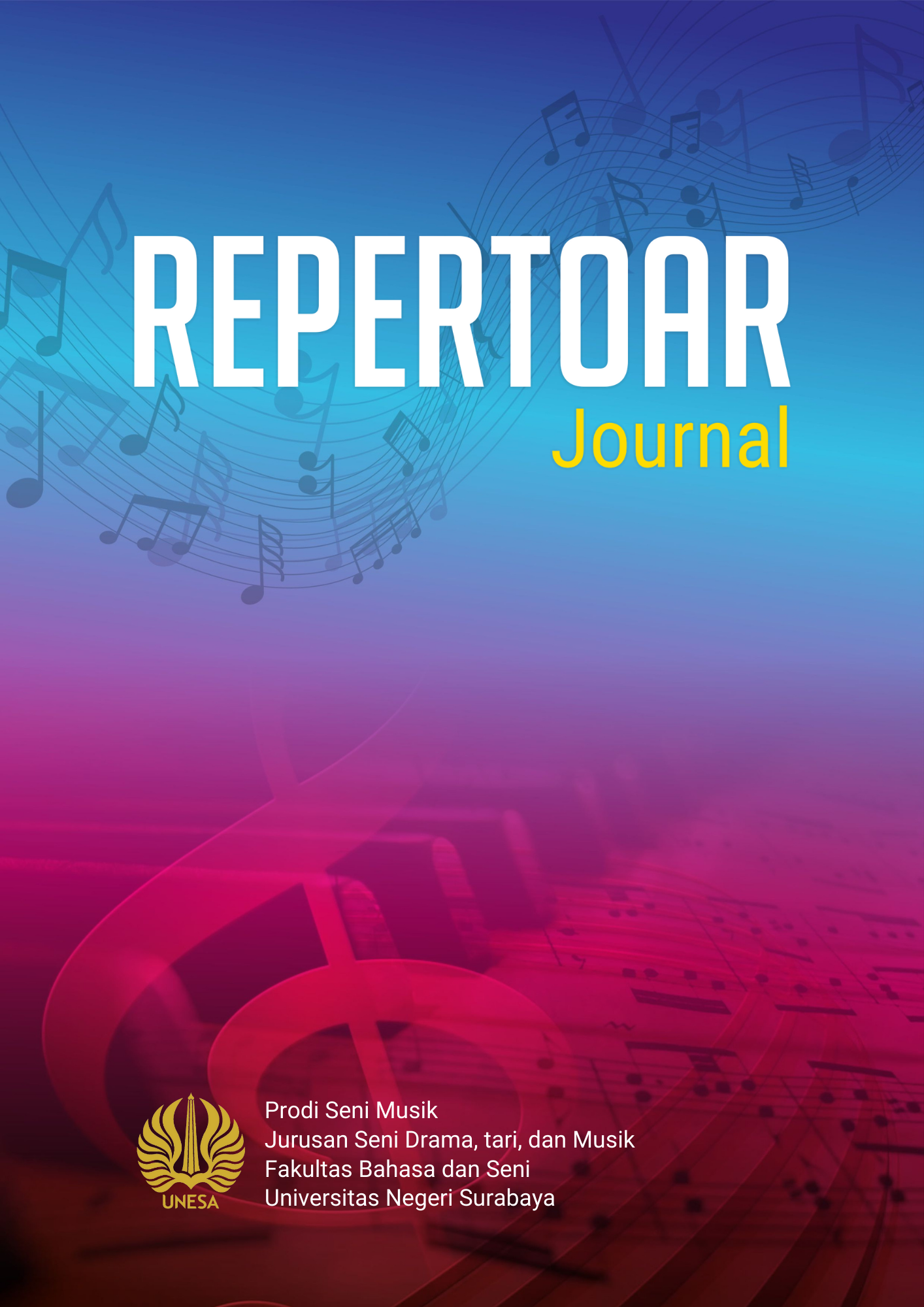Marketing Strategy for the Song "Tell Me" by Saladdays
Main Article Content
Abstract
This research aims to describe the arrangement of the song "Tell Me" and how Saladday's marketing strategy was carried out in marketing the song "Tell Me." This research uses a descriptive qualitative approach to identify and answer problem formulations related to arrangement data and marketing strategies. The data analyzed is the song "Tell Me". Researchers perform data analysis techniques: data reduction, data presentation, and conclusion drawing. This research results in the song "Tell Me" using C# Major tonality with allegro tempo and 4/4 time. The harmony or chords used are extended chords, where there are no triadicelements, and there is only harmony with four or more notes giving rise to chords 7, 9, 11, or 13. The overall musical structure of this song is Intro - Verse 1 - Pre Chorus - Chorus - Interlude - Verse 2 - Chorus - Coda. Then, the chord progression in the central theme of this song is IV - V - VI - V - I. Furthermore, the marketing strategies applied by Saladdays are distribution on the Spotify and Apple Music streaming platforms, pre-release campaigns, distribution on the YouTube platform, and live performances.
Article Details

This work is licensed under a Creative Commons Attribution-NonCommercial-ShareAlike 4.0 International License.
References
Adi William Raharja. (2020). Analisis Bentuk Musik dan Teknik Permainan Cello Pada Sonatine For Cello & Piano Karya Budhi Ngurah. Universitas Negeri Surabaya, 1(1), 11.
Banoe, & Pono. (2003). Kamus Musik (Cet. 1). Kanisius.
Dalimunthe, M. H., & Aslami, N. (2021). Perencanaan dan Strategi Pemasaran Asuransi. VISA: Journal of Vision and Ideas, 1(1), 54–67. https://doi.org/10.47467/visa.v1i1.760
Darmalaksana. (2020). Cara Menulis Proposal Penelitian. Fakultas Ushuluddin UIN Sunan Gunung Djati Bandung, 2.
Dimas Phetorant. (2020). Peran Musik dalam Film Score. Journal of Music Science, Technology, and Industry, 3(1), 91–102. https://doi.org/10.31091/jomsti.v3i1.967
Don Michael Randel. (1986). The New Harvard Dictionary of Music (4th ed.). The Belknap Press of Harvard Univerity Press.
Edi Bond. (2024, May 23). The basics of time signatures: a beginner's guide. Skoove.
Edmund Prier, K. (2014). Kamus Musik. Pusat Musik Liturgi.
Fandy Tjiptono. (1997). Strategi Pemasaran. Andi Offset.
Hugh Milton Miller. (1958). Introduction to Music: A Guide to Good Listening. BARNES & NOBLE, INC.
Jamalus. (1988). Pengajaran Musik Melalui Pengalaman Musik. Balai Penelitian dan Pengembangan Pendidikan dan Kebudayaan.
Kawakami Genichi. (1975). Arranging Popular Music : A Practical Guide. Yamaha Music Foundation.
Kim, S. (2019). 'Now it's indie': The creative turn of the cultural policy in the Korean indie music scene. International Communication Gazette, 81(2), 193–208. https://doi.org/10.1177/1748048518802965
Miza Nina Adlini, Anisya Hanifa Dinda, Sarah Yulinda, Octavia Chotimah, & Sauda Julia Merliyana. (2022). Metode Penelitian Kualitatif Studi Pustaka. Edumaspul, 6(1).
Nugroho, Widyo, & Musafir Isfanhari. (2000). Buku Pengetahuan Dasar Musik (2nd ed.). Dinas P dan K Provinsi Jawa Timur.
Percy A. Scholes, & John Owen Ward. (1970). The Oxford Companion to Music (John Owen Ward, Ed.; 10th ed.). Oxford University Press.
Philip Kotler. (2002). Manajemen Pemasaran Jilid 1 (Milenium). Prenhallindo.
Philip Kotler, & A.B. Susanto. (2001). Manajemen Pemasaran di Indonesia. Salemba Empat.
Prier, S. (2011). Ilmu Bentuk Analisis. Pusat Musik Liturgi.
Prier, S. (2012). Ilmu Harmoni (16th ed.). Percetakan Rejeki Yogyakarta.
Rusandi, & Muhammad Rusli. (2021). Merancang Penelitian Kualitatif Dasar/Deskriptif dan Studi Kasus. Al-Ubudiyah, 2(1).
Sugiyono. (2013). Metode Penelitian Kuantitatif Kualitatif dan R&D. ALFABETA, CV.
Suyanto M. (2007). Marketing Strategy Top Brand Indonesia (1st ed.). Andi.
Syafiq, & Muhammad. (2003). Ensiklopedia Musik Klasik. Adi Cita.
Wisma Tegar Septian, & Grendi Hendrastomo. (2020). Musik Indie Sebagai Identitas Anak Muda Di Yogyakarta. Universitas Negeri Yogyakarta, 9(1), 2.

